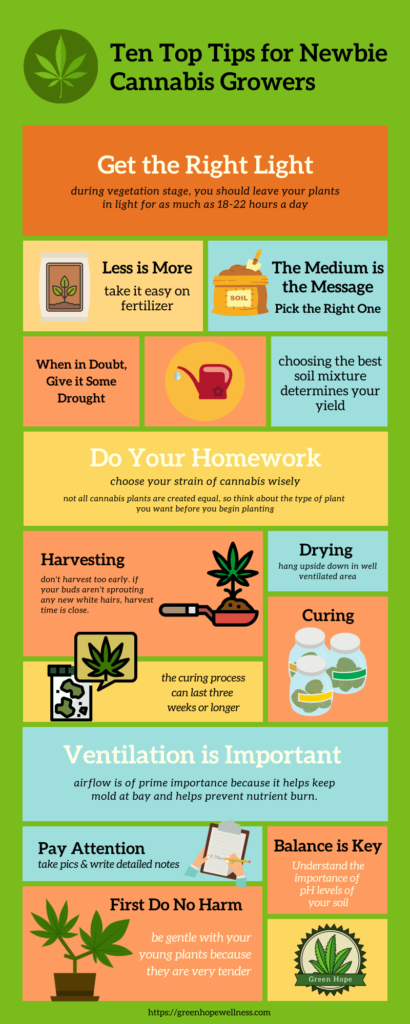“It’s an ill wind that blows no one any good.” So said John Heywood in his proverb collection of the 1500s. This proverb is just as true today as it was long ago. The ill wind in question here is the shutdown of society and life as we know it due to the recent Coronavirus pandemic —know hereafter as ‘Rona. The silver lining that has come out of this is that people are becoming more independent and self-sufficient—
even growing their own food and cannabis. For newbies, growing your own cannabis can seem an overwhelming task. There are huge amounts of information out there, and some of them are contradictory. Most of us just want a basic list of tips to get us started. With that in mind, here are some growing tips that will get you started on your own rewarding, self-sufficient growing journey.
Tip #1: Get the Light Right
When your plants are in the vegetative stage—that period between germination and flowering—they are busy carrying out photosynthesis and storing vital resources to be used for flowering and reproduction. During this stage, you should leave your plants in light for as much as 18-22 hours per day while your plants are experiencing a great deal of growth and progress. Once your plants move on to the flowering stage, you
might be tempted to do the same. This is where most newbies stumble. When your plants reach the flowering stage, you should decrease the amount of light they receive down to 12 hours per day.
Why is this, you might ask? Contrary to what you might believe, plant growth in this stage is triggered by darkness, rather than light. Keeping your photo-flowering plants in constant light will keep them in the vegetative stage. When you grow cannabis outdoors, the seasons will naturally regulate this light and dark requirement. However, you can also place your plant in darkness to help your plants out.
Tip #2: Less is More: Take it Easy on the Fertilizer
Ever been around someone who wears way too much cologne? Yeah…sometimes less is more. Fertilizer is like a multivitamin—providing broad spectrum nutrition to plants. But contrary to what you may think, Cannabis plants don’t require much in the way of added nutrition. Give them just enough to prevent vitamin deficiencies, and they will take care of themselves. Cannabis isn’t called “weed” for no reason!
Too much fertilizer can cause a nutrient burn that starts at the tips of the leaves and spreads slowly if the condition isn’t remedied. Leaves that are burned by excess nutrients aren’t able to create and store energy. This ultimately lessens the amount of yield, and ain’t nobody got time for that!
Another reason not to overfeed your plants is that if you do they will have a noticeable chemical taste and smell, and they will have a lower THC content. A good rule to follow is to give your plants half the daily recommended amount of nutrients and only amp it up once your plants exhibit signs of nutrient deficiency. The rule of less is more especially applies to cannabis nutrients in the fertilizer.
Tip #3: The Medium is the Message: Pick the Right One
One of the most important factors in growing Cannabis is the medium or the composition of the soil in which you grow it. These plants are most happy and thrive best when planted in a soil mixture that doesn’t hold too much moisture. For example, sandy soil drains faster, stays drier, and doesn’t retain as much moisture as clay soil does. Choosing the best soil mixture determines in large part what your yield will be. Choose a mixture of light soil that drains well. Some containers tend to hold more water as well, so choose natural containers that allow for good drainage.
Tip #4: When in Doubt, Give it Some Drought
Drought stress is brought on in plants when water is insufficient. Allowing the leaves of your plants to wilt a bit between watering—just enough to make the leaves curl at the ends and not stand up straight before watering them again stresses the plants, but ultimately leads to the increased potency of your product. Like humans, plants undergo a series of hormonal changes when under stress.
We usually think of stress as a bad thing, but it’s really necessary for survival. The stress response helps us navigate our ever changing environment, and it’s the reason we can react and respond appropriately to new situations. Plants are no different. The best rule to remember is a little bit of stress activates resilience, but too much stress destroys that same resilience.
If you keep up this drought stress during the entire flowering stage, the harvest you obtain will be more potent than from plants that were watered liberally. This is because THC and other compounds will become more concentrated in the buds of the plants which are watered sparingly. We harden our soldiers by putting them under duress. This makes them more resilient in the long run. Plants aren’t much different. Too much water “dilutes” the potency of your plants, so when in doubt, give them some drought!
Tip #5: Do Your Homework: Choose Your Strain Wisely
It’s important to do your homework when it comes to the strains of Cannabis available for planting because not all cannabis plants are created equal. You need to think carefully about the type of plant you want before you begin planting.
Cannabis strains vary in terms of the size of the plants, the concentration of different compounds (CBN, THC, etc.), the aroma of the buds, as well as the effects one experiences after consuming them. It’s important to remember that resistance to adverse conditions, such as pests and diseases, overfeeding, underfeeding, extreme heat or cold, and even over-enthusiastic training, also varies from one strain to another.
This can be overwhelming for new growers, so pick a reliable source for your plants—a source that has educational resources to help you choose wisely.
Tip #6: Harvesting, Drying, and Curing are Key
In the excitement of your plants coming of age, it can be a temptation to harvest too early. Or perhaps too late if you are nervous about harvesting too early. The best rule here is to watch your plants—to really know them. The clues for proper harvest timing lie in the buds. If your buds aren’t sprouting any new white hairs, this means harvest time is close. Closely observe the hairs on the buds and begin harvesting when approximately half of those hairs have become dark in appearance. This dark color lets you know that the compounds in the buds have reached their highest level of concentration, so any delay will cause them to start dwindling.
After harvesting, take the time to dry those buds in a dark, well-ventilated location. Hang them upside down when drying them. You will know that they have dried if the stems snap rather than bend when you manipulate them. Drying the buds is of course only half the work. Even more moisture is hidden inside those buds. This is where the curing process comes in. Place the buds in dark containers and seal them, only opening the container once a day for about a minute to allow dry air to get in while moist air is expelled.
How long should curing last? Why not try some when you are opening the containers to let dry air in. Is there mold on the buds? If not, good! No condensation on the container’s walls? Good! Is the taste and smell satisfactory when you smoke a sample? Good! At this point, stop curing the buds and seal them tightly until you are ready to start smoking them. The curing process can last three weeks or longer.
Tip #7: Ventilation, Ventilation, Ventilation
Make sure your grow space is ventilated adequately. Airflow is of prime importance because it helps keep mold at bay and helps prevent nutrient burn. Spider mites, fungus, gnats, and other pests also thrive in places with insufficient airflow. As you can see, many of the problems that cannabis growers face can be sidestepped if the grow spaces are adequately ventilated for proper airflow.
 Tip #8: Pay Attention: Take Pics and Write Detailed Notes
Tip #8: Pay Attention: Take Pics and Write Detailed Notes
Oscar Wilde once said that “the palest ink is stronger than the finest memory.” He was right of course. How many of us have been totally sure we wouldn’t forget something, only to have it slip our minds after some time has passed? Taking pictures to document every stage of your plants’ growth, while writing down detailed notes will serve two purposes. First it will help you troubleshoot when your have plant problems, and second it will be a a great reference for future grows. Course correction in the middle of a grow is much preferable to starting over.
Tip #9: Balance is Key
Understand the Importance of pH Levels pH is a measure of how acidic/ alkaline a substance is. The scale runs from 1 to 14. A level of less than 7 indicates acidity, while a level of more than 7 indicates alkalinity. Both extremes are toxic. Lye is a base (alkaline) that is very caustic, while hydrochloric acid can also kill. If the pH balance of your soil is off, your grow results will be less than spectacular. This may be the missing piece in the puzzle. The pH of your soil can make some nutrients unavailable to the roots of your plants, even if those nutrients are available in the medium. Find out what the ideal pH range for the specific medium you are using is and check whether yours has gone out of that range. Adjust accordingly, and your plants will thrive once more!
Here is a simple video of how to measure your soil’s pH balance: https://youtu.be/mZgxUqoJMcg
Tip #10 First Do No Harm: Be Gentle with Your Plants
Be gentle with your young plants just as you would be with a small animal or young
child. Don’t shock the plants by doing something drastic or sudden including changing
the amount or type of light, water, temperature, etc. Evolution is always preferable to
revolution! If you must adjust things, do it gradually.
When it is time to switch to the nutrients for the flowering stage, don’t stop providing
those for vegetative growth one day and use only those for flowering on the next day.
This abrupt change will shock your plants and decrease your growth rate. It is better to
introduce any change to your plants gradually so that they can adjust appropriately
without any decline in their growth.
To Recap:
• Get the Light Right
• Take it Easy on the Fertilizer
• Pick the Right Soil and the Right Plant Strain
• When in Doubt, Give it Some Drought
• Harvest, Dry, & Cure According to Best Practices
• Ventilate, Ventilate, Ventilate
• Take Pictures & Detailed Notes
• Pay Attention to Soil pH
• First Do No Harm


